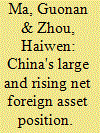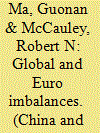|
|
|
Sort Order |
|
|
|
Items / Page
|
|
|
|
|
|
|
| Srl | Item |
| 1 |
ID:
090934


|
|
|
|
|
| Publication |
2009.
|
| Summary/Abstract |
China's emergence as a major player in world trade is well known, but its growing role in global finance might have been underappreciated. China is the second largest creditor in the world today, with a net creditor position of 30 percent of GDP in 2008. We test the importance of the growth differential, demographics, government debt, financial depth and the exchange rate in shaping China's net foreign asset position. Our empirical results highlight the sharp fall in the young-age dependence as one key driver behind China's puzzlingly large net lender position and also confirm the neoclassical prediction that faster growth attracts more capital inflows. Looking ahead, our findings suggest that China will unlikely turn into a meaningful net debtor nation over the next two decades.
|
|
|
|
|
|
|
|
|
|
|
|
|
|
|
|
| 2 |
ID:
130971


|
|
|
|
|
| Publication |
2014.
|
| Summary/Abstract |
We analyze global and euro area imbalances by focusing on China and Germany as large surplus and creditor countries. In the 2000s, domestic reforms expanded the effective labor force, restrained wages, shifted income toward profits and increased corporate saving. As a result, the Chinese and German current account surpluses widened, and that of Germany has proven more persistent, with subdued domestic investment. China is an early-stage creditor, holding a short equity position and a long position in safe debt. Germany's balanced net debt and equity claims mark it as a mature creditor that provides insurance to the rest of the world. China pays to lay off equity risk, while Germany, by contrast, harvests a moderate yield on its net claims. In both economies, the shortfall of the net international investment position from cumulated current account surpluses arises from exchange rate changes, asymmetric valuation gains, and, in Germany's case, credit losses.
|
|
|
|
|
|
|
|
|
|
|
|
|
|
|
|
| 3 |
ID:
152506


|
|
|
|
|
| Summary/Abstract |
This paper considers interactions between China's domestic and external imbalances and their global implications. We present scenarios detailing how a rebalancing of China's growth pattern from investment-driven growth towards more consumption-driven growth may occur in practice. Using input–output tables for 2012, we illustrate the knife-edged nature of Chinese rebalancing, the linkages between expenditure-side and production-side rebalancing, and how an internal rebalancing could exacerbate external imbalances. A policy implication for China is that for rebalancing to be fast, consumption must be exceptionally resilient and the efficiency of investment must increase sharply. If rebalancing is too slow, the capital-to-output ratio will rise to potentially unsustainable levels and consumption will fail to attain levels of contemporary upper middle-income economies by 2030. Global input–output tables (1995–2011) suggest that the patterns of Chinese rebalancing considered in our scenarios may generate substantial headwinds for exports to China by its trading partners.
|
|
|
|
|
|
|
|
|
|
|
|
|
|
|
|
| 4 |
ID:
070888


|
|
|
| 5 |
ID:
140231


|
|
|
|
|
| Summary/Abstract |
Where policy has substantially increased central bank assets, the corresponding liabilities present an opportunity to increase the breadth, depth and liquidity of the government bond market. In China's case, transformed illiquid central bank liabilities could double or triple the stock of government bonds. Central bank liabilities can be transformed into government bonds either through the government's purchase of foreign exchange reserves held by the central bank or by the government overfunding its borrowing requirement and depositing the proceeds in the central bank. The overfunding approach is preferred if, for financial stability reasons, it is judged prudent to leave the central bank with sufficient resources to serve itself as lender of last resort in foreign currency to the banking system. In the case of China, public debt consolidation could also contribute to further liberalizing the Chinese banking system, wider international use of the renminbi and more balanced holdings of key currency government bonds.
|
|
|
|
|
|
|
|
|
|
|
|
|
|
|
|
|
|
|
|
|